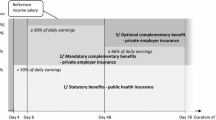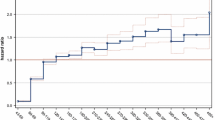Abstract
This article analyzes the effect of stricter enforcement of the eligibility criteria in the Swedish sickness insurance (SI) system. In 2008, time-restricted assessments of the individual’s working capacity on the 91st and 181st sick day was introduced. Taking advantage of the quasi-experimental feature of the intervention, I find a large and significant increased exit rate around the 181-day assessment. The impact is the result of longer spells outside SI-benefits, indicating that the stricter rules create disincentives to report sick.
Similar content being viewed by others
Explore related subjects
Discover the latest articles and news from researchers in related subjects, suggested using machine learning.References
Allison PD (1995) Survival analysis using the sas system—a practical guide. SAS Institute Inc, Cary
Barr N (2004) Economics of the welfare state. Oxford University Press, New York
Black DA, Smith JA, Berger MC, Noel BJ (2003) Is the threat of reemployment services more effective than the services themselves? Evidence from random assignment in the UI system. Am Econ Rev 93(4): 1313–1327
Carling K, Edin P-A, Harkman A, Holmlund B (1996) Unemployment duration, unemployment benefits, and labor market programs in Sweden. J Public Econ 59: 313–334
Dolton P, O’Neill D (1996) Unemployment duration and the restart effect: some experience evidence. Econ J 106(435): 387–400
Hesselius P, Persson M (2007) Incentive and spill-over effects of supplementary sickness compensation. Arbetsmarknadspolitisk utvärdering. Working paper No 16
Hesselius P, Johansson P, Larsson L (2005) Hur påverkar kra-vet på läkarintyg sjukfrånvaron? Erfarenheter från ett socialt experiment IFAU. Report No 7
Hesselius P, Johansson P, Nilsson P (2009) Sick of your colleagues absence?. J Eur Econ Assoc 7(2–3): 583–594
Hägglund P (2010) Rehabiliteringskedjans effekter på sjukskrivningstiderna. ISF. Report No 1
Hägglund P (2011) Are there pre-programme effects of Swedish active labour market policies? Evidence from three randomised experiments. Econ Lett 112(1): 91–93
Johansson P, Palme M (1996) Do economic incentives affect work absence? Empirical evidence using Swedish micro data. J Public Econ 59: 195–218
Johansson P, Palme M (2002) Assessing the effects of a compulsory sickness insurance on worker absenteeism. J Hum Resour 37: 381–409
Johansson P, Palme M (2005) Moral hazard and sickness insurance. J Public Econ 89: 1879–1890
Johnson TR, Klepinger DH (1994) Experimental evidence on unemployment insurance work-search policies. J Hum Resour 29(3): 696–717
Klepinger DH, Johnson TR, Joesch JM (2002) Effects of unemployment insurance work-search requirements: the Maryland experiment. Ind Labor Rel Rev 56(1): 3–22
Meyer B (1990) Unemployment insurance and unemployment spells. Econometrica 58: 757–782
OECD (2009) Sickness, disability and work: breaking the barriers—Sweden: will the recent reforms make it? OECD. Report
Socialförsäkringsutredningen (2006) Mera försäkring och mera arbete. SOU. Report No 86
Swedish Social Insurance Agency (2009) Sjukfrånvaron i Sverige—På väg mot europeiska nivåer. Social Insurance Report No 10
Author information
Authors and Affiliations
Corresponding author
Rights and permissions
About this article
Cite this article
Hägglund, P. Do time limits in the sickness insurance system increase return to work?. Empir Econ 45, 567–582 (2013). https://doi.org/10.1007/s00181-012-0618-9
Received:
Accepted:
Published:
Issue Date:
DOI: https://doi.org/10.1007/s00181-012-0618-9




